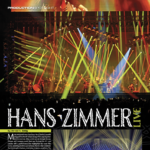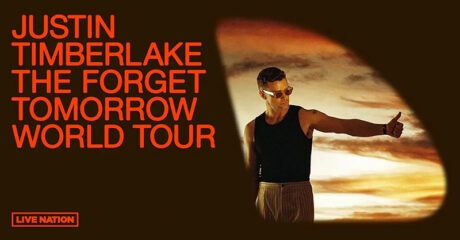
Justin Timberlake’s current The Forget Tomorrow World Tour features a dynamic and kinetic design from Silent House Productions’ Baz Halpin and Cory FitzGerald, that is a true production technology marvel. Halpin handled the Production Design and was Director for the show; FitzGerald was the Lighting Designer for the tour; and Gabriel Coutu-Dumont of Silent Partners Studio led the video content team. The creative team, along with TAIT and Solotech as vendors for the technology on the tour, have not only supported Timberlake’s musical narrative but have, literally, moved the design watermark to a whole new level.
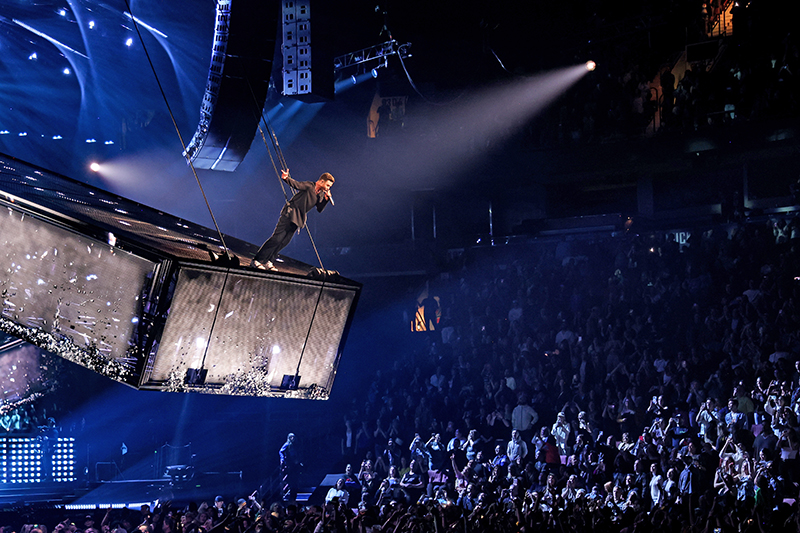
Design Development
The design aesthetic for this tour is very clean and minimalistic. That is not to say it is simple, it is certainly far from that, in fact, it is quite complex. The design at its core is primarily a large video surface for both I-Mag and affected I-Mag that has been integrated with the storytelling content along with various 3D scenes, backgrounds, and vistas. A key element is what the tour refers to as the ‘monolith’, which is a enormous rectangle of video screen, nearly 30’ high X 16’ wide, with 6 1/2’ of depth, that moves out of the flat back wall covered in semi-transparent LED video panels on the front, top, and sides, with a performing surface on the back side.
The design goes from a stage that can appear completely empty to quickly transforming to very dynamic and visually compelling thanks to the impressive automation, scenic, video and lighting merged in this production. “The band is on lifts that can drop them down below the stage,” explains Halpin. “Behind the stage we have a large light wall with towers of lights that come up and fills the 72’ width of the upstage. Of course, we have our 110’ wide video screen with a three-dimensional monolith, which is approximately 30’ x 16’, in the center of the screen. That unit nestles seamlessly into the video wall for the beginning of the show then the LED video wall cracks open and the monolith comes forward. The show is centered around the idea of the monolith, which is a big statement piece. We can go from an empty stage with nothing on it and have Justin in a single spotlight and not see anything else then growing to lights everywhere, a big LED screen, and a monolith that can tip and rotate, spin, Justin can climb on top of it and do all sorts of stuff. We wanted versatility.”
LD FitzGerald describes how the lighting layers into the overall design, noting “The lighting element is there to drive the musicality and help support the full visual picture. The video tells a story; the monolith is a character in the show and it’s very much about the interaction between this object, Justin, the dancers and the band. We asked ourselves, ‘How do we help tell the story and turn it into a dynamic live concert experience?’ The idea of the lighting is to build on the overall design concept and then extended it out to make fill the room. I spent a lot of time focusing on the key lighting, making it unique, moody and musically dynamic. The rest of the show was creating the spectacle and complimenting the entire visual picture.”
Keeping the design for this tour and all the elements—scenic, lighting, and video—tightly integrated into a cohesive whole really supports Timberlake’s high energy performance. While this is the first Timberlake tour for Halpin and FitzGerald, Coutu-Dumont has had a longtime working relationship with the performer. “Gabriel of Silent Partners, who did the video content, has been a longtime collaborator of ours,” says Halpin. “And he’s got a history with Justin. So, we all very much developed the concepts in parallel with Justin, who was incredibly involved. Justin’s awesome. He’s a great person to work with and we had a blast. The way the design came about wasn’t typical; it didn’t just come from me pitching the artist an idea, it came from me putting a book together for him with 120 pages of ideas, imagery, art, architecture, things that were interesting in the technological world, etc. Also, Justin is a cinephile. He speaks by referencing directors and DPs when he is talking stylistically about how we want something to look. As we distilled and went through that document, the design revealed itself in a way, through the imagery that he was gravitating towards.” FitzGerald agrees it was a strong collaboration, adding that “Justin is a huge collaborator. He is definitely someone who was very involved with and knows what’s going on. He had very specific wants and requests. He was involved at every step of the way in communicating with all the departments.”
A Monolithic Statement
The large video canvas became apparent from those creative conversations. Halpin continues, “Then as we went through the imagery, it became clear that we wanted a single statement. It needed to be versatile, it needed to be multipurpose. We had an idea where a lot of the album artwork—and the concept behind the album—was this idea of Justin looking at himself. So, you have a set that we built for some of the photography, for the Al artwork, which was a desert scene with a gas station. Everything to scale and Justin’s there, but then we have a video version of Justin who appears as a giant sort of manipulating that environment. So, it’s very Being John Malkovich—the watcher, watching himself as subject. We came up with the ability to have the big video Justin, referencing small Justin. For the opening of the show ‘Justin’ appears on the video screen performing out to the audience, then, towards the end of the rap, he looks down at the stage and on the center lift, the real Justin rises out of the stage. The eyes of the video ‘Justin’ follow the real Justin as he rises. You have this moment of connection between the two. That theme carries itself through the show. We wanted the ability to have something where we could have a giant version of Justin referencing himself on stage. So, being able to have a monolith that then could track downstage and be right behind on the downstage center position would allow us to do that. As we started to tick all these boxes of narrative requirements and practical requirements, and then add some old-fashioned spectacular moments, this concept of a monolith revealed itself.”
As a part of the cohesive design, the creative team talked a lot about layering lighting and video together. “Since the first meetings we spoke about ways to do lighting behind the screen,” points out FitzGerald. “The video screen is a blow through surface with fixtures behind the screen, different fixtures within the monolith itself, as well as the rig above the screen, with additional positions for key, side, and front lighting for the performers throughout the show. We spent a lot of time during the rehearsals to marry the worlds—to light the scene for the I-Mag and Notch effects, as well as so the audience could see the performances. Finding those balanced moments of color, brightness, and of course, dynamics. I didn’t want to use a lot of dead-on front key light with Justin. It was about trying to find other ways to light him from the side, from the ground, from the footlights, from the top—so the scene would have impact.”
He continues, “With the monolith constantly moving in space, it became a challenge with angles and not spilling light on the monolith itself. ‘How do we light him when he’s in different positions, and around the monolith is in different positions?’ The key was having a lot of tools to be able to change the shape of the stage—pretty dramatically—as far as what worked; that was definitely part of the design and rehearsal process. We learned a lot from previz and renders, but when onsite we got good at pivoting with some of the realities of size, weight, and actual location. Finding ways to get things exactly in the same spot no matter what room we were in and finding the compromises for the smaller venues and the main show. That happens with every show, but this was a very specific footprint, with a very specific size screen that dictated a lot of that, no matter what we did.”
A Production Marvel
One design element that was very specific and uncompromising was the monolith. It is a complex piece that encompasses scenic, automation, rigging, video, and lighting elements. The creative team approached TAIT with the idea and explained what they wanted it to do. The actual monolith measures 29.53’ H x 16.4’ W x 6.56’ D and is covered with semi-transparent LED video panels on the front, top, and sides, with a performing surface on the back side. It’s saturated with video and includes lighting units mounted inside the actual element itself. And it all moves, and we mean really moves, flies, tips, spins.
“The monolith is incredible,” states Halpin. “We put all our eggs in the one basket. We knew we were going to TAIT when we had this crazy idea of the monolith, and they did an incredible job. It weighs 11,000 lbs. and with the whole track and rotator comes in about 33,000 lbs.. Plus, the actual speed it can rotate, move, rise up and down, as well as how accurate it is, is really amazing. The fact that it’s surrounded on three sides with video tiles, and it’s got lights inside, and Justin can walk, and perform, on top of it. There’s a winch built in so he can get up to the top and ride it as it tips over and it flies out over the audience.”
FitzGerald wholeheartedly concurs, calling the monolith and its automation ‘a modern marvel’, saying that “the speed at which it can move, the accuracy and safety involved is immense. To see them pick up, basically what would be something the size of a small venue stage, and spin it around at what seems ‘very fast’ was awe inspiring to watch. Knowing how much it weighs and how big it is, it doesn’t really compute until you’re standing underneath it. It’s pretty awesome.”
For the video cladding of the monolith, the design team knew that they had to keep the video panels weight light, and they knew they wanted a blow-through panel. This allows for the lights inside the massive structure to shine through. The choice was made to go with ROE Visual’s Vanish V8T-GOB product as it ticked all the creative and practical boxes. “In terms of the video tile, I was very clear we needed to be lightweight, and we wanted blow through, but we wanted it to be high contrast, and high resolution,” explains Halpin. “We’d conducted an LED shootout for my show Awakening at the Wynn in Las Vegas with about six different products. The ROE V8T turned out to be the best choice. What was really surprising was that it wasn’t necessarily the highest resolution, but I knew we could get a great, high-quality image and we do.”
Lighting Choices
“A lot of things, especially the lighting choices within the monolith, came down to weight,” says Halpin. “We had a maximum weight that it could be, and we wanted as many fixtures as we could possibly get into the monolith—and we wanted versatility. So, Cory came up with the ACME Pulsar that’s got a strobe on one side and a beam fixture on the other and is a moving head. It is a great little fixture that packs a punch as well as a ton of features.”
FitzGerald points out, “We had the awesome Chauvet COLORado PXL Curve 12s and the ACME Pixel Lines. The PXL Curves are truly unique. Of all the things I’ve used in my career, to have so many people not on the lighting team come up and say, ‘I’ve never seen anything like that before’, was great. I’ve been lucky to get to use new fixtures a lot in my career, but to have the whole non-creative team look at the PXL Curves and be like, ‘wow, that’s really different’, was definitely a cool new experience.”
For his design beyond the monolith, FitzGerald used the double duty ACME Pulsar fixture on the band riser and Robe MegaPointes on the 72’ wide wall of lighting towers behind the ROE Vanish LED screen. “We had an array of gear. For key light we used the Robe iFORTE LTX FollowSpot with the Robe RoboSpot controllers. I love the level of control with the RoboSpots; the ability to change color and things from the console is obviously great, but they also have very good repeatability. Then we had an array of VL3600s and Chauvet Color STRIKE M strobes. I also used the VL3600s and STRIKE M strobes over the B-stage area; just a simpler lighting rig around the bar/B-stage to give a more intimate feel for the songs that Justin performs out there.”

Production Support
For the lighting, video, and audio, the tour selected a single vendor, all were supplied by Solotech. The scenic fabrication and automation were provided by TAIT. Both companies worked together to realize the design. Halpin and Silent House have a long history with both companies and were confident they were the right choices. “It was fantastic working with Solotech,” says Halpin. “They’re always a great partner and they’re great problem solvers. Nothing is ever a problem; they never complain about anything. They treat every show like it’s their first show and put their best foot forward. TAIT were great as well—Logan Lower was the Project Manager, and [TAIT President, Projects] Brian Levine led the project. Look, it’s always fun to design something that they are really excited about. Over the years I’ve done so many cool and interesting things with TAIT, but this monolith… I think they were really excited about it, and they should be very proud of it because it is just incredible what they did.”
FitzGerald was very pleased with Solotech, “They are great. I think the coupling of them, being the vendor for all of the departments, and Silent House being the overall design team led to a very streamlined process of figuring out what was possible; what had to change; what we could push and pull. It gave us full control over what we wanted to do creatively, what we could do technically, and how we could best achieve it with the time and budget. It gave us a lot of power to help make that happen very quickly and very accurately. It was a good combo between design team and Solotech as the vendor that helped keep it streamlined and effective.” He further thanked “the Lighting Programmer Davey Martinez and Lighting Director Josh Beard, who is out running the show, and then our Lighting Crew Chief, Corey Tom, and the whole Solotech crew is great. Obviously, Lee Moro and John Flynn from Solotech as well were so supportive.”
FitzGerald also gives “a shout out for the support from Design Producer Vincent Richards from our Silent House office helped with the creative and did a lot of the logistical work on making sure the design happened and stayed on top of all the details. He was invaluable during the build and setup process on the concepting side, the drawing side, and working closely with TAIT.” As for TAIT, he reiterates, “The monolith is a marvel, incredible work by TAIT.”
Standout Moments
For Halpin, there are a few standout moments and songs that he likes. “There’s a song called ‘Drown’ where we filmed Justin inside the monolith. He performs this mid-tempo ballad, and the monolith is all the way downstage. The monolith appears to be filling with water as he performs. It was the last piece of content to come in so it was something I was very worried about, but it ended up looking incredible. Then for ‘Cry Me a River’, the monolith is doing an incredible 360° rotational spin as it’s tilting and moving up and down. It’s just an amazing piece of Navigator programming and is super high intensity. That is about halfway through the show; it’s pretty incredible. Then for ‘Mirrors’, with him standing on the monolith coming out over the audience; being able to tip that over and have him leaning forward all the way on the edge of the monolith. That is certainly a moment that stands out.”
The encore song ‘Mirrors’, with Timberlake riding out on top of the monolith is one of FitzGerald’s standout moments as well. “It’s a great finale to the show,” he comments. “We’ve seen all these things happen with the monolith, and then all of a sudden Justin comes out on top of the monolith and it just all makes sense. There are certain moments where the monolith flips itself around and becomes a ceiling and then moves up to reveal the scene underneath. There are some really clever ways that the monolith, and the overall design actually, ties in the video, lighting, and physicality of the space; that really uses the space in a new way. It uses all the different departments together as one big thing, and it feels cohesive, and very intentional.”
If speaking with another touring music professional, Halpin notes he would call out “that when we were crafting this—the set list and the show—the flow of the show came first and everything was built around it. To me, it’s the marriage of the music and the visual and it’s the sequencing of where the highs and lows are. At no point does the technology or the visual overtake Justin. It always feels purposeful and supportive. Nothing ever feels accidental or superfluous. I think that’s hard to do.” For FitzGerald, he points to the fact that, “We were all on the same page to make it all happen cohesively; the show and the pieces fit together nicely.”
Production Team
- Tour Manager: Dan McGee
- Production Managers: Luke Larson, Robert “Hydro” Mullin
- Creative Designer/Director: Baz Halpin
- Lighting Designer: Cory FitzGerald
- Design Producer: Vincent Richards, Silent House
- Video Content: Gabriel Coutu-Dumont, Silent Partners Studio
- Lighting Director: Josh Beard
- Lighting Programming: Davey Martinez
- Video Programming: Manny Conde
- Technical Director: Zach Peletz
Gear
Lighting
- 54 ACME Pulsar S2
- 213 ACME Pixel Line IP
- 116 Chauvet Color STRIKE M Strobe
- 103 Chauvet PXL Curve 12
- 29 Robert Juliat Dalis 864
- 70 Robe MegaPointe
- 54 Robe ESPRITE
- 15 Robe iFORTE LTX
- 53 Vari-Lite VL3600
- 100 Tyler Truss GT Truss, 10’
- 4 Tyler Truss GT Truss, 5’
- 2 Rigging Kits, each with:
- 140 LIFTKET 1-Ton Hoist
- 24 LIFTKET 2-Ton Hoist
- SHOWSDT Hoist Control
Video
- 371 ROE Visual V8TGOB LED Panel
- 4 Barco UDX4K 32K Projector
- 2 16×9 Front Projection Screen
- 3 Panasonic PLV100 Cameras w/ Fujinon Cabrio Lens
- 2 LUNA Tower Cam Setups with B20 Remote Heads
- 1 LUNA Dolly Cam with B20 Remote Head on Track @ A-Stage
- 4 Panasonic UC4000 Cameras w/ Fujinon UA Broadcast Lens
- 1 Handheld Wireless ABonAIR System @ C-Stage
- 3 Panasonic Lumix BGH1 Camera
- 1 FIN Cam mounted to LUNA Dolly Cam
- 1 Steadicam with ABonAIR Wireless System
- 2 Apple iPhone 15 with Blackmagic App @ C-Stage Bar
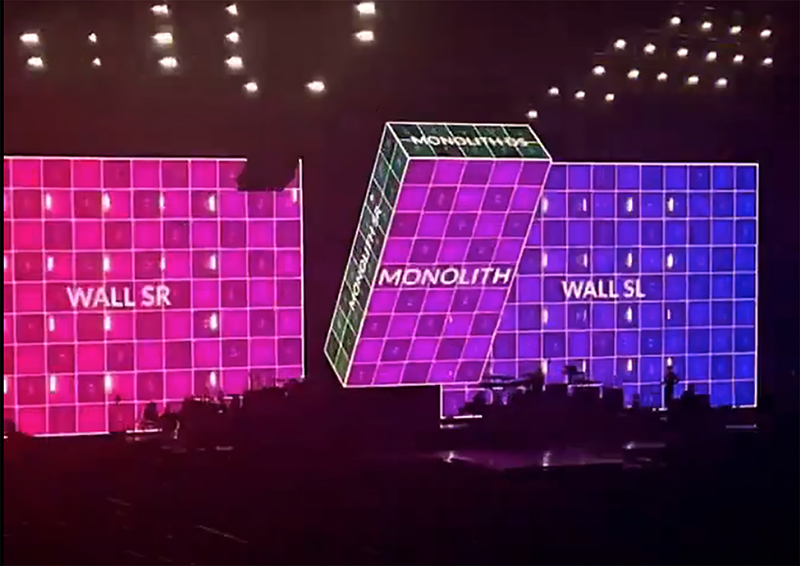
VENDOR VIEW: SOLOTECH
Lee Moro, Senior Vice President-Live Productions:
On the solutions Solotech brought to this tour
The production faced several significant challenges, including the incorporation of lights inside the monolith; achieving tight corners with custom LED panels; using a unique LED product that was both transparent and lightweight; managing the weight; and ensuring 360° mobility. To address these challenges, Solotech’s Steve-O Grinceri collaborated closely with Baz Halpin, the Silent House team, ROE, and TAIT. Together, they developed a solution that allowed for perfect 90° corners on the monolith, ensuring it met up seamlessly with the large tracking wall, and designed custom LED panels to achieve the necessary tight corners, which was essential for maintaining its sleek, seamless appearance. They also meticulously integrated the lighting within the monolith. Additionally, the team overcame the challenges of weight and 360° mobility by leveraging the unique properties of the transparent and lightweight LED product, ultimately realizing the ambitious vision. The ability to spin 360° with this amount of weight and creative needs was a challenge—but with this group of people it came to life better than expected.
On a particular solution of note
One particularly fascinating solution was the ability to transmit data via fiber optic cables while allowing the monolith to rotate a continuous 360°. This truly was an engineering feat that required innovative thinking and precise execution. To achieve this, the team utilized a TAIT designed slip ring, a specialized component that allows for the continuous transfer of data, power, and signals while rotating. Traditional cabling would have been unable to handle the constant movement, leading to potential tangling or breakage. However, the slip ring enabled the fiber optic cables to rotate seamlessly with the monolith without any interruption in data transmission.
The slip ring’s integration required careful planning and collaboration among the engineering team, ensuring that it could handle the high-speed data required for the custom LED panels and lighting within the monolith. This solution maintained the integrity of the visual and functional aspects of the design, proving essential for the monolith’s sleek and seamless appearance. This innovative approach to managing data transmission in a dynamic environment showcases how overcoming technical challenges can lead to groundbreaking solutions that enhance the overall impact of a production.
On supporting designers Cory FitzGerald and Baz Halpin
We worked very closely with Cory on the overall look of the show, incorporating new effects and using products like the Chauvet PXL Curve and the ACME Pulsar. Everyone was particularly pleased with the Vari-Lite VL3600, which served as the workhorse of the show. Solotech’s John Flynn collaborated extensively with Cory to manage the weight and power consumption requirements, ensuring we stayed within production constraints.
It’s always a pleasure being able to bring Baz’s visions to life. For this tour, he brought in Sam Wrench as Director of Photography to ensure the show was presented in a more broadcast-friendly, film-style manner compared to traditional touring I-Mag. The I-Mag integration was unique. Perfectly timed and placed to enhance each moment of the performance. Another fun and unique aspect of the production was the monolith, known as ‘Blockie’, who even has its own Instagram page (@blockytimberlake). Blockie became a character in its own right, engaging fans with behind-the-scenes content and updates. This level of character development for a production element is rarely seen, adding an extra layer of engagement and personality to the show.
On the Solotech Team behind the Timberlake Tour
We are incredibly proud to have worked alongside such amazing partners on this project, including our in-house Solotech team. Special recognition goes to John Flynn for overall technical advisement and to our Project Manager Eamon McCullagh and his team, as well as all our technical leads and team members. Of course, none of this would have been possible without our dedicated touring team. Their hard work and expertise in managing a production of this size and scale, are essential to the tour’s success. Their dedication and professionalism truly makes the difference to the show coming together.
Why was Solotech the right vendor for this production?
Solotech fosters seamless communication among all parties involved. From Production Managers Hydro[Robert Mullin] and Luke Larson to the teams at TAIT, Baz Halpin, Cory FitzGerald, Vincent Richards at Silent House, and Dan McGee, everyone felt comfortable and well-coordinated. This trust and communication made the project run smoothly, ensuring a successful and efficient collaboration.
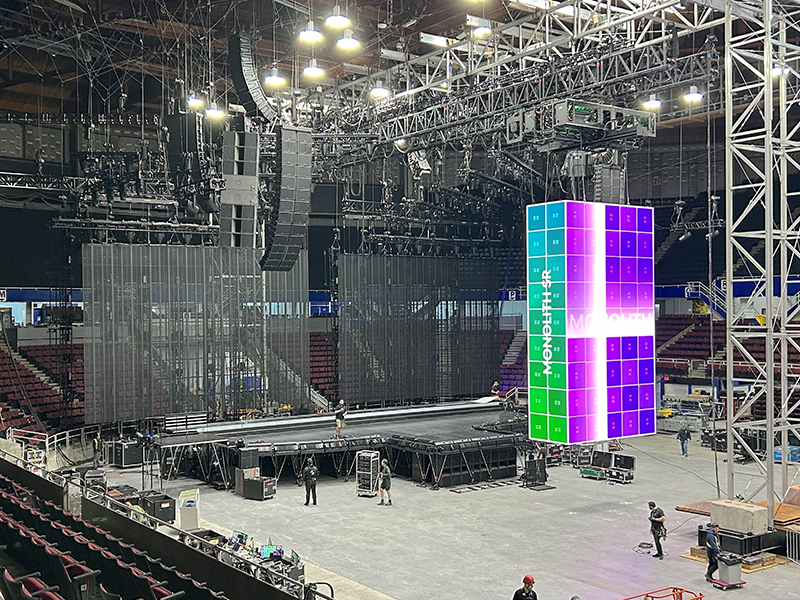
VENDOR VIEW: TAIT
Creative Director Baz Halpin’s production design for Justin Timberlake’s The Forget Tomorrow World Tour includes a massive 110’ wide video wall upstage of the performance area. Though it appears to be a seamless video wall there is actually a center section, 16.4’ wide, dubbed ‘the monolith.’ The monolith measures 29.53’ H x 16.4’ W x 6.56’ D and is wrapped on the front face, sides, and top with LED video panels, with the back clad with perforated deck. The LED product wrapping the monolith is ROE Visual’s Vanish V8T-GOB product with custom panels to create seamless edges at the 90° corners and that is mounted to a custom TAIT frame. In addition to the Navigator automation control, TAIT created the interior structure that also supports lighting fixtures mounted within.
Part way through the show, the monolith moves downstage out of the LED wall surprising the audience. Throughout the rest of the show, the monolith not only moves forward and back but also rotates, lifts, tilts, and spins. For a mind-blowing encore maneuver, Timberlake rides on top of the monolith like it is a monstrous surfboard— as it flies out soaring 90’ over the audience. Halpin comments about working with TAIT, “Over the years I’ve done so many cool things with TAIT, but this monolith is amazing… they should be very proud of it because it is just incredible what they did.”
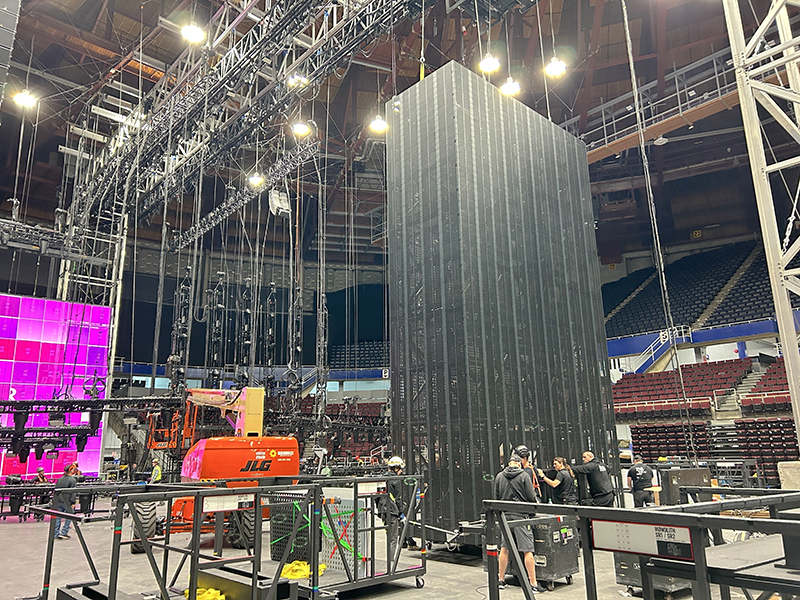
Paul Sapsis, Technical Lead & Logan Lower, Sr. Project Manager, TAIT:
On developing the monolith solution
Cory and Baz are great to work with because they come at us with these out of the box ideas. They wanted to create something that was going to have this huge ‘wow’ factor and they were really interested to hear feedback and about what capabilities we could help deliver to achieve something that had never been done. We provided them with a range of visualizations of how we thought the monolith could move. We did a bunch of small-scale models to make sure that what we were developing together was the thing that they actually wanted.
There were a couple of key requirements. The first requirement was they wanted it to be hidden in the upstage video wall at the start of the show. Second, they wanted it to be able to track pretty much half the length of the arena. Then they wanted to be able to tip it end over end, and they wanted it to be able to rotate 360° endlessly.
The original challenge was to define what we thought a typical arena tour could handle. There’s a limit on roof capacity and there’s a limit on what human beings can get done in a day. We knew that we had to be within a single day load-in for this effect. So, a lot of the solution was governed by what we either thought we could physically move or what the building could hold up; those considerations defined the size and scope of the effect.
On the details of the monolith
Essentially, it is a ‘brick’ of semi-transparent video with a performing surface on one side [the rear] and video surfaces on all the other sides; it’s saturated with video and the lighting effects. It weighs 11,000 lbs. and can rotate at three RPM. It can lift at two feet a second and it can match those speeds and acceleration traverses at two feet a second as well. It can endlessly rotate. We used a few stock things, but we don’t use them in stock ways. The winches are custom, the rotational elements are custom. When it lifts, it takes the rotator with it. You could compare it to a Broadway turtle. There are two traversing gantries—two trusses tied with a gantry system. In the center of the gantry system, there’s a slew ring bearing; a big crane bearing. Then underneath that we’ve got four independent winches acting as two groups lifting up the front and back of the monolith itself. Then nested inside of all of that, you’ve got a performer lift and travel for Justin’s performer flying.
On the custom ROE Visual’s LED video panels
The LED video panels are a custom ROE product [ROE V8TGOB]. That was a challenge in and of itself—making three corners of video all meet semi-seamlessly is something. We don’t want to say it hasn’t been done, but certainly in this way, that’s a piece of kit I haven’t seen before. Between TAIT, Solotech, and [PM] Hydro, we got into development on the project really early, and identified the need for an incredibly lightweight frame, but also one that was going to allow us to index three corners together and make this seamless image. With TAIT helping guide the design process and ROE’s ability to manufacture at incredible velocity, we were all able to come together to make the product that worked.
The collaboration with Solotech, from day one, was key and we were lucky enough that their team was able to move in lockstep with us going through the development of this. When they saw the need to have three video surfaces all meet up, Solotech also knew that it was going to be a custom solution. They got ROE on the phone. Solotech helped get ROE up to speed and through a very quick prototyping process. That allowed us to really make good progress in the early stages of development, defining what the structure was. Then throughout the initial build and install, we had Solotech here alongside us.
The attachment for the video product is also bespoke. Each tile has tapped holes in the corners and then there’s all these brackets that go from the structure to the video product itself and get fastened into place. It’s a custom solution for a custom product. It’s not like a standard touring frame. In terms of mounting for the lights inside the monolith, we used the omega brackets on the fixtures, and we created a whole pattern inside of the internal framing that the omega brackets could bolt. Everything tours mounted to the frame of the monolith.
On the touring realities of the monolith
The monolith breaks into five horizontal slices and those slices then break into three vertical sections. We designed it to be left in as big chunks as possible. Essentially weight was the governing factor. That’s the most important thing. Size can change, look can change, manufacturing can change, weight cannot change. To achieve that, we built in the modular sections that would attain that and that we could move in a truck. If we could have moved it in bigger sections, we would have because that would save us weight. The connection methodology costs us in weight and so we built it in as big as sections as we could and still be able to move them. It all fits into three trucks. The monolith itself takes up the entirety of two trucks, and then the truss and all the lifting equipment that lives on the gantry, that’s the third truck. It takes four hours to load-in the monolith.
The dead hangs for this system are one of the coolest parts of this system, because it helps them get it in the air quickly. The monolith travels over the audience, constrained to a straight line—two tracks, two meters apart for a 110’ of total track. For the 110’ of track, we only use eight chain motors. It’s 11,000 lbs. for the monolith, but the real mass is in the gantry and winch payload. The actual monolith portion of it represents about a third of its actual mass. The rest of that mass is used in the lifting equipment. So, we’ve got about a 22,000 lb. rolling load above this 11,000 lb. thing that turns into this very big rolling mass. Then you put dynamics, E-Stop factor, and overhead safety factor and you’ve got a big thing you need to constrain only in specific places because the weight moves around. What we do is we build it on a chain motor patch that’s directly on top of the load during the build. Then we set dead hangs using come-alongs and conventional rock and roll steel technology above us to constrain the rest of it. If we had done it on chain motors, we’d need somewhere between 48 and 52, 2-ton hoists because of the way we’re doing it with dead hangs, we’re down to eight, which is pretty cool.
On the use of the monolith in the show
Baz really builds an arc to the show. Part way through the show, we open the video wall, and push the monolith in behind Justin to close down the look, and then from there we build on those looks trick by trick, moving it to an angular position, rotating it, increasing the speed of that rotation, increasing the dynamics of the rotation, leading all the way up to Justin, flying on it at the end of the show. We load Justin up stage of the monolith, when it’s back inline with the main video wall. He essentially climbs the back of it using the performer winch, and we position him in a way that we’re able to deploy the wall with him surfing on it. He comes from a horizontal position to vertical, then as the song builds, we start to do these tipping looks with the monolith; he performs with it flat and at an angle with him leaning forward in his harness. We can tip forward because on the upper corner of the monolith there are these things we call ‘knuckles’, which allow the wire rope past their lifting point to break an edge, which lets the thing keep rolling past where the lifting point is. So, the wire rope finds a new redirect point around those knuckles. There is a moment in the song then when we push Justin and the whole monolith to its furthest extent out over the audience, which is something just south of 90’ of travel. We are all very proud of how it well it works.
